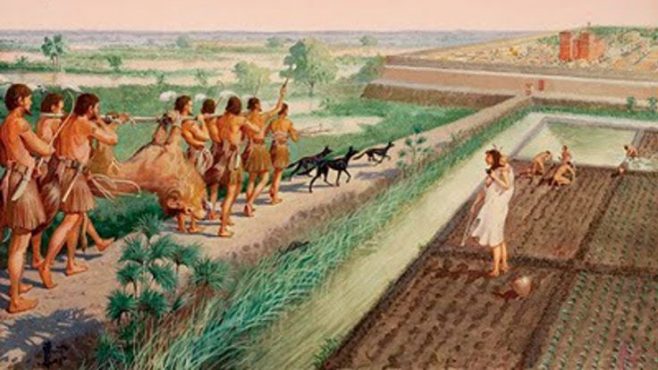
When farmers encountered hunter-gatherers around 10,000 years ago, the interaction was more an explosion of love than hate, new DNA evidence suggests.

For much of human history, our ancestors were hunter-gatherers, mostly nomadic people who lived by hunting, fishing and harvesting wild food. Around 10,000 years ago, farming developed in Western Asia and quickly spread across Europe and to other parts of the world. The ancient lifestyle shift begs the question: What happened when the farmers first encountered the hunter-gatherers?
New DNA evidence reported in the journal Current Biology helps to provide the answer by showing that, at least in the area now known as Romania, hunter-gatherers and farmers were living side by side, intermixing with each other, and having children.
It was not necessarily love at first sight, though.
“Farmers arrived very suddenly, as a result of a fast expansion,” co-author Andrea Manica of the University of Cambridge said. “It is likely that they lived side by side with local hunter-gatherer populations for a period of time — centuries or even a millennium or two — with increasing contact and mixing among the two communities.”
 Manica, lead author Gloria Gonzalez-Fortes, and their international team came to these conclusions after recovering four ancient human genomes from Romania dating to between 8.8–5.4 thousand years ago. For context, they analyzed two hunter-gatherer genomes from Spain, as well as other known early genomes from these European regions.
Manica, lead author Gloria Gonzalez-Fortes, and their international team came to these conclusions after recovering four ancient human genomes from Romania dating to between 8.8–5.4 thousand years ago. For context, they analyzed two hunter-gatherer genomes from Spain, as well as other known early genomes from these European regions.
Co-author Clive Bonsall from the University of Edinburgh explained that indigenous hunter-gatherers can be distinguished archaeologically from immigrant farmers by their material culture, such as artifacts, architecture, burial traditions, art, and body ornamentation. The two groups also differ in subsistence practices, determined by food refuse preserved in the archaeological record and chemical analysis of human remains.
“For example, in our study region, hunter-gatherers did not cultivate or raise livestock, although they did keep domestic dogs,” Bonsall said. “They did not use pottery, and buried their dead in a different way.”
The DNA analysis revealed that the early Romanian genomes had significant input from Western hunter-gatherers, but still showed a sizable contribution from Anatolian farmers. This suggests that some hunter-gatherers and farmers were mating and raising children.
The scientists suspect that the challenging climate of the region might have caused the farmers to supplement their diet with food from hunter-gatherer activities, helping to bring the two distinct groups of people together.
Chemical investigation of related human bones demonstrates that the joining of the two cultures broadened the diets of each. Bonsall said early Southeast European farmers cultivated cereals, such as wheat and barley, and legumes, like peas and lentils. They also raised sheep, goats, cattle, and pigs.
They additionally consumed some dairy products, even though all of the individuals examined in the study were lactose intolerant. Co-author Eppie Jones of the University of Cambridge explained that “the mutation, which allowed people to drink milk into adulthood, has not been found in Europe before the Bronze Age (starting around 2300 B.C.).”
The hunter-gatherers, on the other hand, brought plenty of nuts, plant foods, fish, and shellfish to the table. Some hunter-gatherers along the lower Danube River were so good at fishing that they lived in more permanent settlements, known as fishing villages.
Previously it was thought that farmers horned in on the hunter-gatherer territory and outcompeted the native populations, but the DNA evidence indicates that, at least in some cases, the two groups managed to live together despite large cultural differences.
Jones mentioned that the new findings, combined with prior research, reveal that “the amount of mixing between the groups varies in different regions of Europe. In Central and Western Europe, the incoming farmers largely replaced the local populations, while in areas further north, such as the Baltic, farmers didn’t make much of a genetic impact.”
“In Romania,” she continued, “we found that there was a mix of these two processes, (such that) hunter-gatherers and farmers were sharing both their culture and genes.”
In future, the researchers hope to learn more about the hunter-gatherer and farmer admixture to figure out if it was mostly due to hunter-gatherers being integrated into farming communities, or if it resulted from some other dynamic.
By Jen Viegas
Suorce: https://www.seeker.com/culture/archaeology/ancient-hunter-gatherers-and-farmers-made-love-not-war
Dünyalılar (www.dunyalilar.org)
